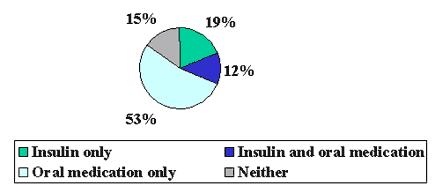Treatment of Type I
Diabetes ![]()
| Insulin-Insulin treatment is still the best method of treatment for those with afflicted with Type I diabetes. It's usually extracted from the pancreas of a pig, as their anatomical structure is vastly similar to ours. Insulin is taken via injection or an insulin pump. There are five types of insulin available in treatment: rapid acting, short acting, intermediate acting, long acting, and pre-mixed. Dosage of insulin is available in either 100cc or 500cc; also referred to as U-100 and U-500. | |
| Islet Cell Transplantation-Insulin producing beta cells are taken from a donor's pancreas and transplanted into the diabetic's pancreas. However, there are risks associated with this as there is a need for further immunosuppressive therapy due to the transplantation of foreign tissue. Until 1999, attempts at this procedure were only 8% successful. Today, thanks to more effective techniques and anti-rejection drugs, success was 100% in a Canadian clinical trial done in 1999. This is an exciting area of research that may highly benefit those with Type I diabetes in the future. | |
| Type I diabetics maintain a low-sugar, low-carbohydrate healthy diet to help regulate blood sugar levels in addition to medication. | |
| In cases where gestational diabetes cannot be managed through diet changes alone, insulin may also be administered. |
(Source: WebMD)
Treatment of Type II
Diabetes ![]()
| Treatment with insulin and/or oral medications among adults is varied, with some adults not receiving any treatment at all. | |
| Oral medication-along with changes in diet and lifestyle-is the most common form of medicinal treatment for Type II diabetes. These drugs are not insulin. Rather, some medications such as sulfonylureas, thiazolidinediones, and meglitinides stimulate the pancreas to produce more insulin; whereas others such as biguanides (most popular type: Glucophage) improve insulin's abilities to move glucose into the cells, Alpha-glycosidase inhibitors block enzymes that help digest starches, and sulfonylureas + biguanides combination drugs stimulate the pancreas to produce more insulin, improve its effectiveness, and reduce the liver's secretion of glucose into the bloodstream. | |
| A major focus of treatment for those with Type II diabetes, gestational diabetes, and pre-diabetes is diet and exercise regulation. Decreased body fat leads to increased insulin sensitivity, reduced complications due to obesity, and lowered blood glucose levels. |
(Source: WebMD)
Treatment with Insulin or Oral Medications-
United States, 1999-2001

(Source: 1999-2001 National Health Survey)
Self-monitoring of
Glucose Levels and Complications ![]()
| Blood glucose monitors, normally utilizing a lancet that draws a small amount of blood and tests for the level of glucose in the sample, are the most common types of home-monitoring systems. |

| Time of Test | Ideal for Adults With Diabetes |
| Before meals | 90-130 mg/dL |
| Before bedtime snack | 180 mg/dL |
| *Source: American Diabetes Association, position statement 2003 | |
(Source: Web MD)
| To prevent the aforementioned complications, frequent visits to specialists concerning eye care, kidney functioning, dental care. etc. is greatly encouraged. |